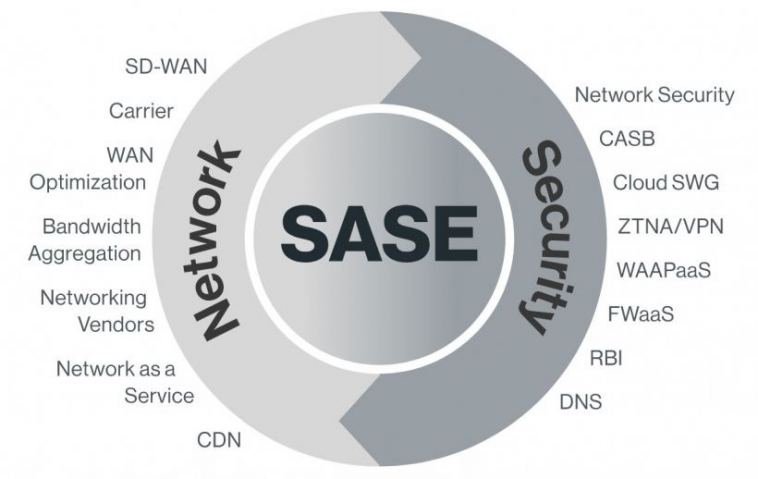- Like
- SHARE
- Digg
- Del
- Tumblr
- VKontakte
- Flattr
- Buffer
- Love This
- Save
- Odnoklassniki
- Meneame
- Blogger
- Amazon
- Yahoo Mail
- Gmail
- AOL
- Newsvine
- HackerNews
- Evernote
- MySpace
- Mail.ru
- Viadeo
- Line
- Comments
- Yummly
- SMS
- Viber
- Telegram
- JOIN
- Skype
- Facebook Messenger
- Kakao
- LiveJournal
- Yammer
- Edgar
- Fintel
- Mix
- Instapaper
- Copy Link
Introduction
Secure Access Service Edge (SASE) is a networking solution for the corporate WAN. Cloud-based SASE points of presence (PoPs) combine the network optimization of SD-WAN with a fully-integrated security stack. It provides a number of benefits compared to traditional cybersecurity solutions.
Optimized Network Performance
One of the primary objectives of SASE is to improve the network performance of the corporate WAN. It accomplishes this by a combination of software-defined WAN (SD-WAN) optimized routing and security integration.
SD-WAN is designed to securely and efficiently route traffic between nodes in a network of SD-WAN appliances. If these appliances are deployed at common endpoints and globally distributed to support remote workers, like SASE PoPs are, then routing traffic over the corporate network is almost as efficient (and potentially faster) than sending it directly over the public Internet.
The main challenge of SD-WAN is that a full security stack must be deployed with each SD-WAN appliance to perform traffic inspection and security policy enforcement. SASE’s security integration makes this possible, allowing SASE to provide all of the benefits of SD-WAN network routing optimization without sacrificing enterprise visibility or security for business traffic.
Integrated Security
SASE’s integrated security is crucial to optimizing traffic routing over the corporate WAN. However, this is not the only benefit of security integration.
Many organizations are reliant upon an array of security appliances designed to address specific attack vectors or endpoint requirements. The complexity of such an arrangement makes it difficult for a security team to perform network monitoring and threat detection. Additionally, the need to individually configure, manage, and maintain each solution takes away time and resources from protecting the network.
SASE devices are designed with a fully integrated security stack, which gets rid of the need for an assortment of standalone devices and simplifies configuration and management. Furthermore, security integration can offer performance benefits as the various security components are designed to work in unison.
Broad Device Support
As telework becomes more common, employees are working from a greater variety of devices. One of the biggest changes is a growth in the use of mobile and Internet of Things (IoT) devices for business purposes.
The growth of mobile presents a significant challenge for traditional remote access solutions. VPNs typically have poor mobile support, making them difficult to use on these devices, especially for an extended period of time.
SASE solutions, on the other hand, have largely come into being after the growth of mobile had begun. As a result, SASE commonly offers solutions that are explicitly designed to support these devices, making remote workers more efficient and effective.
Managed Network and Security Services
Many organizations are struggling to find the talent that they require to protect themselves against cyber threats. Effective cybersecurity requires a team of experienced security analysts that have deep familiarity and knowledge of the systems that they are using. With the ongoing cybersecurity skills shortage, these skilled personnel can be difficult to attract and retain.
SASE solutions are often offered as a managed service, which includes managed security services as well. Managed security services in general are a means for organizations to scale their security teams; however, partnering with a SASE provider for security has additional benefits.
When securing an organization’s SASE network, the security provider primarily requires an understanding of how their own product works to be effective. SASE includes a full security stack, and security analysts can be trained on a single solution and platform. This makes it possible for a managed SASE provider to offer security monitoring with staff that are experts with the tools that they use.
Network and Security Scalability and Flexibility
Enterprise networks and network requirements grow and evolve in unexpected ways. The COVID-19 pandemic is a prime example of this as the need for secure remote access solutions suddenly ballooned as enterprises transitioned to a mostly or wholly remote workforce.
SASE solutions provide a much higher level of scalability and flexibility than their traditional counterparts. During the shift to remote work, VPN infrastructure was overwhelmed because each appliance has a maximum capacity and VPNs act as point-to-point connections. Adding additional capacity can require multiple new appliances (load balancers, etc.) and a redesign of the network infrastructure.
SASE PoPs, on the other hand, are designed to be deployed as part of a network. Adding a new SASE PoP only requires a configuration update for the rest of the network but can significantly increase the capacity of the network.
SASE PoPs are also more flexible than traditional solutions. With standalone point products, each solution may need to be independently configured to adapt to changing solutions. Since SASE PoPs are identical and deployed as a network, a single configuration can be pushed to all of them and put in place immediately.
Making the Switch to SASE
A properly designed and implemented SASE solution can provide a number of benefits to an organization. However, these benefits are only available in true SASE products. When evaluating options, look for a solution that offers full security integration and cloud-native deployment.


